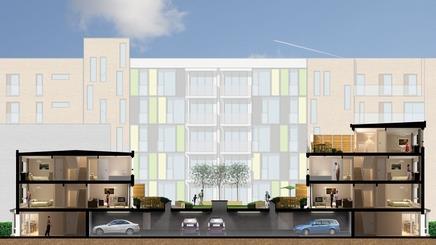Masterplanning high-density developments involves a delicate balancing act between effective land use and environmental sensitivity. David Ellis of PRP Architects maps out the best practice
One of the biggest challenges for any architect is creating places where people actually want to live in the long term and which are attractive as well as buildable. However, there is another hurdle with high-density development, which is how to deliver more useable and high quality external private and public spaces within a building-dominated environment.
There are always conflicting agendas between optimising development capacity, and achieving the best environmental fit for a site in relation to the wider townscape, landscape and environment. At PRP we have identified some aspects of the design and development process that we consider are crucial in reconciling high-density development with a quality external environment.
Development proposals should always start with an appreciation of the existing landscape and townscape characteristics, however obscure these may be. This may include identifying predevelopment landscapes and a site’s history which could inform its distinctive “place making”.
On most of our regeneration masterplanning projects, the solution has generally been to lose a proportion of gross open space on the basis that the regeneration project is re-provided with spaces with a significantly higher biodiversity, recreation and amenity value. Losing open space is an emotive issue and our approach is to provide detailed land classification data based on PPG17, showing direct correlations between existing and proposed conditions so that the merits of the project can be more easily assessed.
Sunlight and daylight issues are a major consideration where densities are significantly increased. The BRE’s Site Layout Planning for Daylight and Sunlight (BRE 209) provides a robust benchmark to determine appropriate massing and configuration of buildings. Compliance with this standard is vital if the quality of external space is to be optimised.
A popular high-density urban block solution is to provide ground level parking with single-aspect ground floor accommodation wrapping around the car parking area. A rear courtyard space is then provided over a slab at first floor level giving amenity spaces for residents. A top-down approach is essential so the slab, venting and drainage are determined in response to the landscape design proposals.
Without exception, all of the best European examples# of high-density housing have involved close collaboration with the local community and municipality in overarching design proposals; down to the specifics of private and communal open spaces and choice of plant material. The most successful masterplanning projects are also developed with the mandate that pedestrian scale and access is the primary driver to site layout and land use. This is fundamental to achieving successful public spaces and landscapes which require surveillance and need to be animated by pedestrian activity.
Play and recreation is an increasingly important dimension to masterplanning for residential development – and the emphasis is on playable landscapes rather than just areas with play equipment. The consequence of this is that a play strategy needs to be imbedded in overall design proposals and preferably early on in the outline planning application stages.
Pedestrian priority
The inclusion of pedestrian priority streets (in contrast to traffic-calmed streets) within residential-dominated development is gathering momentum within the UK. This provides an opportunity to create streets
as spaces for the focus of social activity and children’s play. There is some inertia between planning policy aspirations and the highway authority’s enthusiasm for non-standard street designs. The homezone approach can be adopted, where a balance is struck between vehicular traffic and everyone else who uses the street. This can be an opportunity to create amenity areas where external space is at a premium.
In terms of biodiversity, “brown roofs”, consisting of crushed aggregate, often based on reused waste from site clearance, can provide habitat for invertebrates and certain species of ground nesting birds that would otherwise be vulnerable to predation by domestic animals at street level. This is of particular value on high-density developments where there are few opportunities to incorporate wilderness landscapes within the urban layout and where generating a biodiversity rating for the Code for Sustainable Homes may be desirable.
Fundamentally, the goal is to create neighbourhoods and places where people want to live as opposed to just estates with houses. The most successful examples of these new “places” are consistently ones where the external spaces have been designed as an integral part of the overall masterplan or conceived before the built development. The development process therefore needs to accommodate landscape design input from early feasibility stages through to implementation and management strategy.
Postscript
David Ellis is associate director for landscape and urban design at PRP




























No comments yet